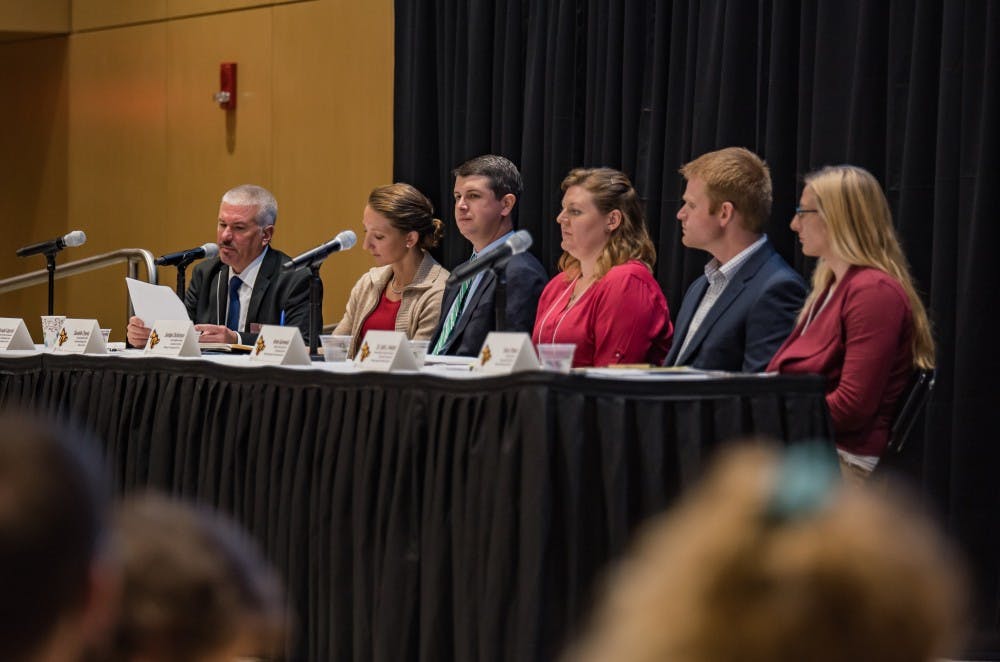Problems facing the Great Lakes discussed at Great Lakes Science in Action Symposium
The greatest time to advocate for the protection of the Great Lakes is from January to March.
This was one takeaway offered by research professionals and policy makers who gathered Oct. 20 in the Biosciences Building to discuss the state of the Great Lakes at the fourth annual Great Lakes Science in Action Symposium.
“We should do everything we can to introduce people from all over the world to these lakes that we treasure, to help them understand the threats they face,” said U.S. Congressman John Moolenaar, R-Midland, a speaker at the event. “We should do it with facts and frank discussion – without hate.”
The event featured speeches by Moolenaar, State Sen. Darwin Booher, and two discussion panels. Topics included the Great Lakes Restoration Initiative, issues concerning invasive species in the Great Lakes and how global temperatures might be affecting the lakes.
The Great Lakes region has a $6 trillion GDP, making it the third largest economy in the world. The lakes are a critical resource that provide a unique ecosystem, and one fifth of the world’s fresh water. They form major trade routes and an international border, making the Great Lakes an international concern.
Moolenaar started the event with his overview of Great Lake concerns at the federal level. Moolenaar is a member of the House Committee on Appropriations, which earlier this year saw a proposal to cut funding for the Great Lakes Restoration Initiative (GLRI).
Protests from several states, including Illinois, Indiana, Minnesota, New York, Pennsylvania, Wisconsin and Michigan, caused the proposal to be thrown out. The House of Representatives passed an appropriation for $300 million to go toward environmental agencies and the GLRI – $157 million of which goes specifically to Michigan.
Moolenaar sees an obvious role for the federal government in managing the Great Lakes region and encourages people to eliminate the idea that the Great Lakes are simply a regional issue.
A national effort
Darwin Booher, state senator and vice chair of the Great Lakes Legislative Caucus, followed up Moolenaar's comments with a discussion on the goals of his caucus. One main goal is the communication between the regions that make up the Great Lake Basin, which include: Illinois, Indiana, Michigan, Minnesota, New York, Ohio, Pennsylvania, Wisconsin and parts of Canada like Québec and Ontario.
Booher ended his speech with an answer to an audience member's question about the best time to advocate for issues concerning the Great Lakes. He stressed the importance of advocacy during the months when budgets are being allocated, and policies are being voted on, which is roughly January to March each year.
“I tell people, there’s no reason for you to advocate for something in the budget in July, August and September, because no one’s looking at it,” Booher said.
After Booher, a panel made of five professionals spoke about current Great Lake issues from the state and federal perspectives. Panel members included:
- Danielle Chesky, Enviromental Affairs officer and Canadian Embassy member.
- Senior legislative assistant Jordan Dickinson.
- Anne Garwood, Great Lakes coastal wetlands ecologist and lead staff on Michigan’s wetland monitoring efforts.
- Seth J. Herbst, aquatic invasive species coordinator for the Michigan Department of Natural Resources.
- Eva A. Vrana, legislative assistant for Congressman Moolenaar.
Faculty member Donald Uzarski, director of the CMU Institute for Great Lakes Research, served as moderator.
One of the topics discussed in the panel was the issue of aquatic invasive species , such as the four species of Asian carp that have been detected in the Great Lakes basin. These species pose a threat to the ecosystem of the lakes and the economy. Other invasive species include New Zealand mud snails and sea lamprey. Herbst works on implementing the invasive species management plan which is funded through the GLRI.
“Prevention of aquatic invasive species is always the most effective use of resources,” Herbst said. “The next step is early detection, eradication and control.”
Last July, Red Swamp crayfish, one of the world’s most widespread invasive species, was detected in Michigan. Since they were detected, there has been active trapping and monitoring to try to reduce any potential negative effects the crayfish may have caused. Citizen science and local groups have been critical to early detection of a species, Herbst said.
A second panel, focusing on Great Lakes science efforts, consisted of:
- Marcello Graziano, Daria Kluver and Andrew R. Mahon, all members of CMU’s Institute for Great Lakes Research.
- Kelly F. Robinson, from the Department of Fisheries and Wildlife.
- Michael J. Siefkes, Sea Lamprey Control Program manager.
Ian Davison, senior vice provost of the Academic Reorganization Initiative, served as the moderator.
One highlight was presented through research by Kluver, who looks at temperature and precipitation patterns and how they are affecting the Great Lakes. Last year was the warmest year globally to date, a 150 year record, and Michigan had the fifth driest month in Sept. on record.
Studying global patterns, Kluver and her colleagues found what happens in the arctic during the spring impacts precipitation in the Great Lakes region in the following fall months.
“This means what happens in the arctic affects us here,” Kluver said. “These global climate problems, like melting sea ice, impact us and we can’t just ignore them. We can’t just not talk about climate change.”




